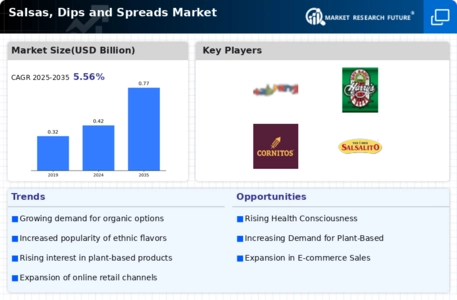Top Industry Leaders in the Salsas Dips Spreads Market

The competitive landscape of the salsas, dips, and spreads market is characterized by robust competition among key players aiming to capitalize on the growing consumer demand for diverse and flavorful condiments.
Leading the pack are major industry players such as
- Front era Foods Inc. (U.S.)
- Britannia Foods (India)
- Tostitos (U.S.)
- Sabra (U.S.)
- Hot Sauce Harry's (U.S.)
- Arizona Spice Company(U.S.)
- Desert Pepper Trading Company (U.S.)
- Ricos (U.S.)
- Cornitos (India)
- Salsalito (India)
These established brands benefit from extensive distribution networks, strong brand recognition, and economies of scale, allowing them to maintain a substantial market presence.
Strategies Adopted:
Key players in the market have adopted various strategies to strengthen their positions and drive growth. A prevalent approach involves continuous product innovation and portfolio diversification, as consumers seek unique and exotic flavors. Companies are investing heavily in research and development to introduce new variants, capitalize on emerging food trends, and cater to specific dietary preferences, such as organic, gluten-free, or plant-based options.
Strategic partnerships and collaborations with retail chains, supermarkets, and foodservice establishments are common strategies employed by these key players. Establishing strong relationships with distributors and retailers enhances product visibility and ensures wide market reach. Additionally, marketing efforts focus on creating brand awareness through promotional activities, advertising, and digital campaigns, leveraging social media platforms to engage with the target audience.
Market Share Analysis Factors:
Market share analysis in the salsas, dips, and spreads market considers multiple factors influencing consumer choices. Quality and taste are paramount, with consumers gravitating towards brands that consistently deliver on flavor expectations. Pricing strategies also play a crucial role, especially in an environment where cost-conscious consumers seek value for their money. Brand loyalty, built over time through positive consumer experiences, remains a significant factor in sustaining and expanding market share.
New & Emerging Companies:
New and emerging companies in the salsas, dips, and spreads market are injecting dynamism into the industry, challenging established players with innovative offerings and niche products. Startups and smaller players often focus on addressing specific consumer needs, such as clean-label ingredients, minimal processing, or unique regional flavors. While these companies may face challenges in terms of distribution and brand recognition, their ability to respond quickly to market trends and consumer preferences allows them to carve out a distinctive space in the market.
Industry Trends:
Recent industry news highlights a shift towards healthier and sustainable product offerings. With an increasing focus on wellness and environmental consciousness, major players are incorporating clean and natural ingredients, reducing additives, and exploring eco-friendly packaging solutions. This alignment with consumer values not only enhances brand image but also caters to the evolving preferences of health-conscious and environmentally-aware consumers.
Current company investment trends underscore a strategic shift towards digital marketing and e-commerce channels. Companies are allocating resources to online platforms, recognizing the growing influence of e-commerce on consumer purchasing behavior. Digital advertising, influencer collaborations, and partnerships with e-commerce platforms are becoming integral components of companies' marketing strategies, reflecting a response to the changing landscape of consumer engagement.
Competitive Scenario:
The overall competitive scenario in the salsas, dips, and spreads market is characterized by a constant pursuit of differentiation and responsiveness to market dynamics. Companies are adapting to evolving consumer preferences by offering products that align with trends such as clean eating, plant-based diets, and global flavor exploration. The battle for shelf space in both physical stores and online marketplaces intensifies, driving companies to invest in packaging innovations and strategic placement within retail environments.
Recent Development
Notable developments have shaped the competitive landscape of the market. Mergers and acquisitions have been observed as key players seek to expand their product portfolios or acquire innovative startups to stay ahead of the curve. Additionally, there has been a heightened emphasis on supply chain resilience, with companies investing in technologies and partnerships to mitigate disruptions and ensure a consistent flow of raw materials and finished products.


